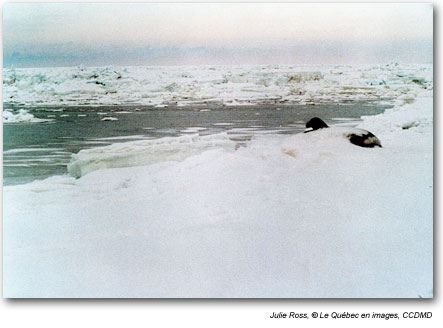ST. LAWRENCE INFO
![]()
The St. Lawrence River and Climate Warming
In the opinion of some experts, a temperature increase of 2 to 4°C could lower the average flow from Lake Ontario by 24%. Lake Ontario is the major source for the St. Lawrence River, and a decrease in flow of this magnitude could result in a 1-metre drop in water levels in some areas of the St. Lawrence.
 |
|
Sunset at Petit-Matane |
The fact is that the Great Lakes region experienced a 0.7°C temperature increase between 1985 and 1991. This temperature increase has resulted in decreased flow at the mouth of the Great Lakes and, consequently, in the St. Lawrence River and its estuary.
 |
|
Source: Bouchard and Morin, 2000. |
Since the 1930s, flow statistics studies have revealed that episodes of low flow occur approximately every 30 years, punctuated by episodes of greater flow that can exceed more than 20 000 cubic metres per second.
If climate warming continues unchecked, in the years to come we can expect to see:
- The expansion of littoral areas and the drying-out of wetlands;
- A decline in water quality due particularly to the lessened dilution of pollutants;
- An increase in concentrations of suspended particulate matter if the sediment load remains the same, and a drop in light penetration; and
- The temporary or permanent relocation of sedimentation zones.
"According to researchers, the average temperature in the Great Lakes basin could go up by about 4.5°C by 2055, with slightly larger increases in winter than in summer. Higher rates of evaporation and drier soils would reduce runoff, and water levels in the Great Lakes could fall by an average of between 0.5 m and 1.0 m, according to typical scenarios. The St. Lawrence River outflow could be reduced by 20%." (Water – Vulnerable to Climate Change 2004).
 |
|
Ice on the river |
While decreased water levels are anticipated in the upstream section of the St. Lawrence River, water levels in the downstream portion can be expected to rise from the upper estuary to the gulf. Indeed, the melting of polar ice and the thermal expansion of ocean masses due to climate warming would lead to an increase in levels downstream.
 |
|
Flooding in the Lac Saint-Pierre archipelago |
 |
|
Shore erosion on the North Shore |
Sea levels are expected to rise by between 20 and 95 cm relative to current levels (IPCC 1995; cited in Loiselle et al. 1997). According to this scenario, current patterns would be modified and shore erosion accentuated due to encroachment of water onto beaches and littoral zones following the formation of temporary and permanent flood zones. In addition, we expect upwellings of salt water at the mouths of rivers and the penetration of water tables by salt water.
To Know More
St. Lawrence Info – Lake Saint-Louis at Risk?
Literature
Bouchard, A. and J. Morin. 2000. Reconstitution des débits du fleuve Saint-Laurent entre 1932 et 1998. Environment Canada, Meteorological Service – Quebec Region. 71 pages.
Loiselle, C., G. R. Fortin, S. Lorrain, and M. Pelletier. 1997. Dynamics and Contamination of St. Lawrence River Sediment. Environment Canada – Quebec Region, Environmental Conservation, St. Lawrence Centre. 125 pages.
Morin, J. and A. Bouchard. 2000. Background Information for the Modeling of the Montréal / Trois-Rivières River Reach. Scientific Report RS-100. Environment Canada, Meteorological Service – Quebec Region. 56 pages.
Morin, J. and J.-P. Côté. Modifications anthropiques sur 150 ans au lac Saint-Pierre : Une fenêtre sur les transformations de l’écosystème du Saint-Laurent. VertigO – La revue électronique en sciences de l'environnement 4(3): 132–141.
Related Links
Québec and the Climate Change Challenge
Government of Canada – Climate Change
Water – Vulnerable to Climate Change
|
|
||||||
|
||||||
|
|
||||||
|
|
||||||
|
|
||||||
|
|
||||||
